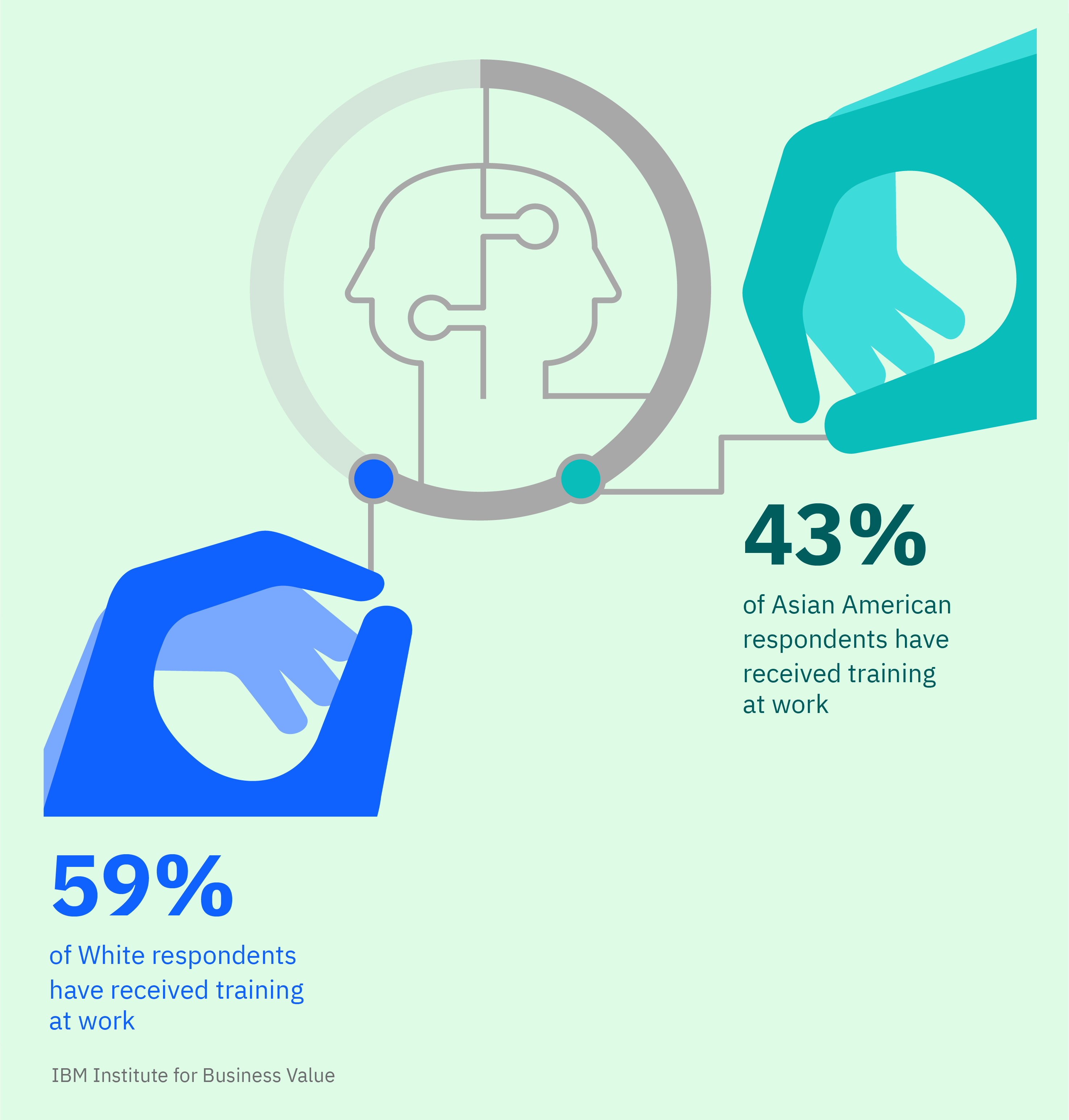Asian American inclusion in the workplace
In early 2021, Asian Americans—sometimes shrugged off as “the model minority”—faced a new wave of public anti-Asian sentiment. As the pandemic threatened “regular life” for everyone, more Asian Americans became targets of hate speech and violence, from labeling COVID-19 as “the China flu” and other racial slurs, to the March 2021 shooting rampage in Atlanta.
The US work environment for Asian American executives is uncomfortably challenging and discriminatory, according to new research from the IBM Institute for Business Value (IBV). Asian American professionals report on-the-job obstacles that far exceed those of their White counterparts.
To explore this topic, the IBV surveyed 1,455 Asian American senior executives, senior managers, junior executives, and entrepreneurs between August 2020 and January 2021. Respondents represented a broad cross-section of industries across the US.
8 in 10 Asian American professionals say they’ve personally experienced discrimination based on their ethnicity or race.
The episodes of anti-Asian hate in American society, which accelerated during the pandemic and escalated further in recent months, have generated an outcry from Asian Americans and allies in the business community. A broad cross-section of Asian American business leaders, for instance, created the website StandWithAsianAmericans.com, taking out full-page ads in The Wall Street Journal and elsewhere. They drew attention to fear in the community, the 150% rise in hate crimes, and issued a pledge to fight back against violence.
Just 3 weeks later, the US Senate passed a bill 94-1 to denounce bias against race, national origin, and other characteristics. The bill cites roughly 3,800 cases of related discrimination and incidents of hate crimes in less than a year’s time, as of February 28, 2021. After passing a House vote on May 18, the bill will soon be signed into law by President Biden.
These efforts recognize that the violence has been disproportionately directed toward Asian women, and that the climate of systemic bias and racism also affects Black, Latinx, Indigenous, and LGBT+ communities. These efforts also represent a call for greater responsibility on the part of businesses to be a voice for change and an ally in support of advancing opportunity more broadly.
Patterns of success—and bias
The narrative of Asian achievement in US business is supported by success stories of entrepreneurs like Yahoo founder Jerry Yang and YouTube cofounder Steven Chen, and chief executives Satya Nadella at Microsoft, Sundar Pichai at Alphabet, and Arvind Krishna at IBM, among others. Yet this anecdotal evidence of Asians in the corner office masks continued limited advancement opportunities for Asians in corporate America.
In the new IBV study, 8 in 10 respondents say they’ve personally experienced discrimination based on their ethnicity or race. Nearly half of all respondents point specifically to discrimination in the workplace. The challenges reported underscore the intense bias Asian Americans still face, even as they advance and succeed in their careers. In fact, more than 60% of respondents report that they must work harder to succeed because of their identity.
This echoes a study by Ascend, an organization that represents professional Pan-Asian Americans, which analyzed the latest EEOC data (2018) across all industries. The Ascend study concluded that, while all ethnic groups are underrepresented at the executive level relative to their professional level, Asian men and women are the most likely to be hired but the least likely to advance to become executives.
The Training Gap: Asian American employees get fewer on-the-job learning opportunities.

These hurdles persist despite the fact that, as IBV’s research shows, Asian American professionals value the approaches that are among the most impactful for organizations and that reflect a future-forward perspective:
- Creating positive change. This is the top-ranked definition of success among Asian Americans in the IBV study. It aligns with what most successful brands and operations are also focusing on, especially with the rising emphasis on social impact and stakeholder capitalism. It outpaces more self-serving goals, such as financial security and accumulating power or influence.
- Prioritizing continuous learning. This is the top-ranked attribute cited for life success among Asian American respondents. It’s perhaps the most valued perspective for both workers and leaders in our change-heavy world, where adaptability is increasingly prized.
- Using effective communication. This is the top-ranked skill cited by Asian American professionals, both for themselves personally and to enable success in America in general. This belies stereotypes of Asians as both STEM-obsessed and reserved in demeanor, assumptions that have historically limited their exposure to leadership opportunities.
In this report, we present detailed results from our study of Asian American professionals, focusing first on the Pan-Asian experience. The respondents’ answers indicate a broad sense of hope and positivity that their efforts, in tandem with societal progress, will address both long-held biases and meet newer challenges. But there is much that organizations—and indeed, all of us—can do to propel that progress forward.
Meet the authors
Inhi Cho Suh, General Manager Strategic Partnerships, IBM Cloud and Cognitive SoftwareBernie Hoecker, General Manager Americas Kyndryl PMO Leader, Global Technology Services
Cindy Anderson, Global Executive for Engagement and Eminence, IBM Institute for Business Value
Originally published 18 May 2021


